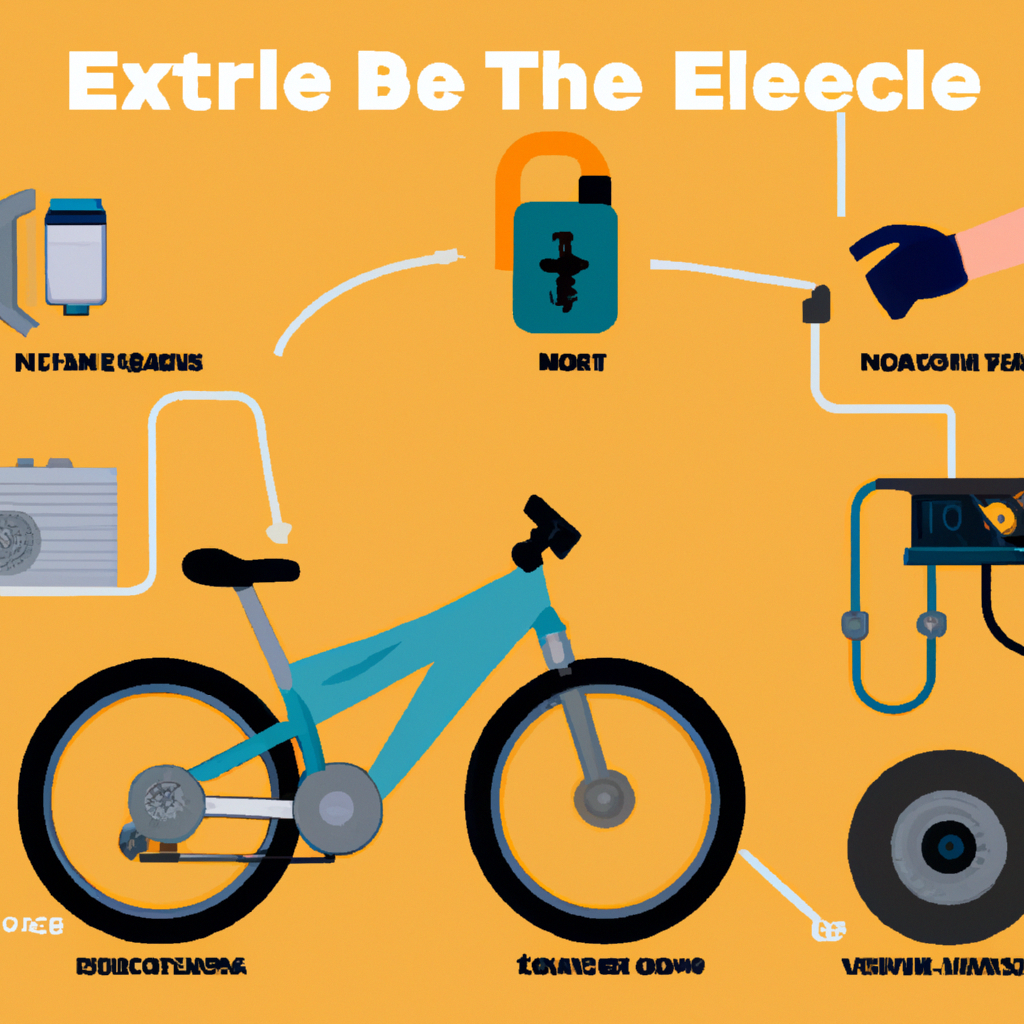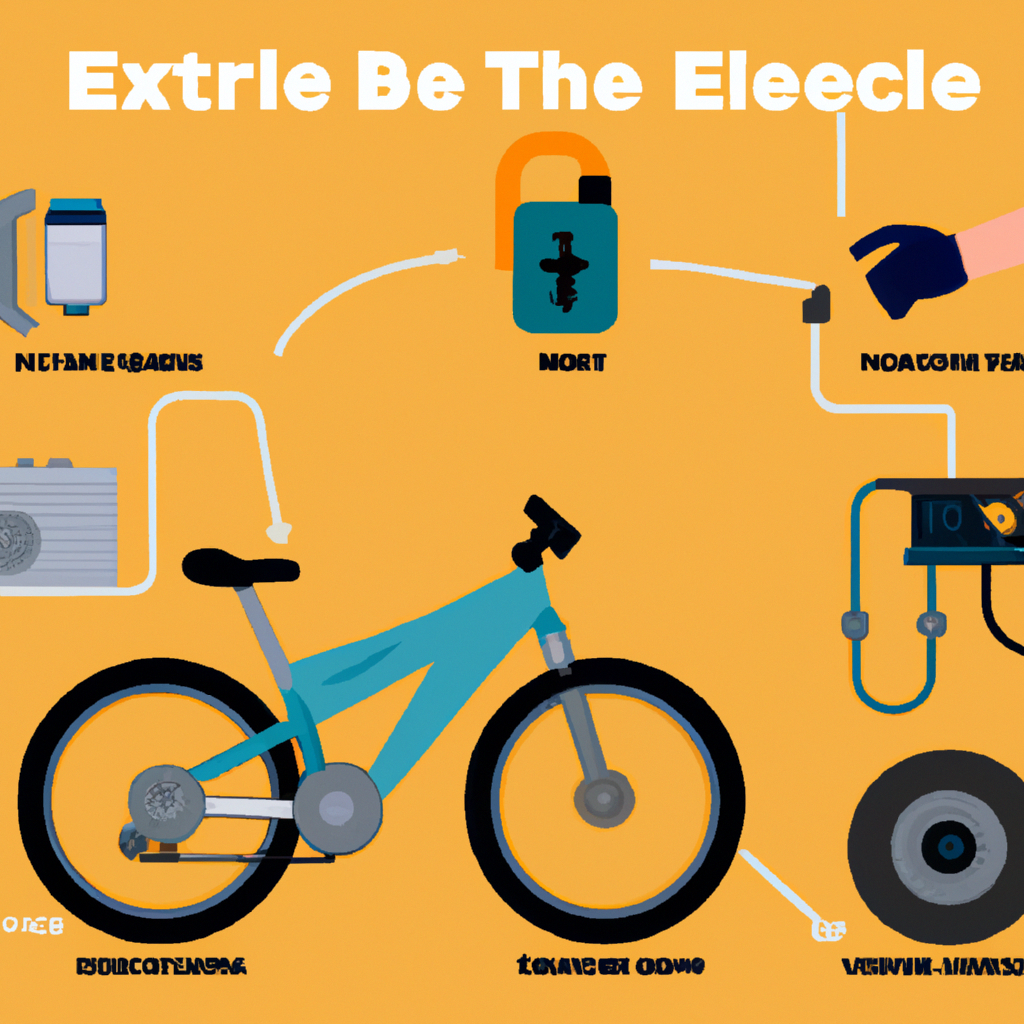Are you a new electric bike rider looking to learn the ins and outs of bike maintenance? Look no further! In this article, we will provide you with a hands-on guide for basic electric bike maintenance. Whether you ride your bike in the city or on off-road trails, this guide will give you all the information you need to keep your electric bike in great shape. From essential tips to step-by-step guides, we’ve got you covered. So, let’s dive in and become confident e-bikers together!
1. Importance of Electric Bike Maintenance
Electric bikes are a convenient and eco-friendly mode of transportation, but just like any other vehicle, they require regular maintenance to ensure optimal performance and longevity. Proper maintenance not only enhances your riding experience but also helps you avoid costly repairs and replacements down the line. In this article, we will explore why maintenance is important, the benefits of regular maintenance, and how to extend the lifespan of your electric bike.
1.1 Why is maintenance important?
Maintenance is crucial for electric bikes because it helps prevent mechanical failures and ensures the safety of riders. Regular upkeep allows you to identify and address any issues before they escalate, reducing the risk of accidents and breakdowns. Additionally, properly maintained electric bikes provide a smoother, more enjoyable riding experience, allowing you to make the most out of your investment.
1.2 Benefits of regular maintenance
Performing regular maintenance on your electric bike offers a multitude of benefits. Firstly, it improves the overall performance and efficiency of your bike. By keeping the components clean, lubricated, and adjusted, you can enjoy better speed, acceleration, and battery life. Regular maintenance also helps extend the lifespan of your bike by preventing premature wear and tear of vital parts. Moreover, it gives you peace of mind, knowing that your bike is in top shape, reducing the chances of unexpected breakdowns or malfunctions.
1.3 Extending the lifespan of your electric bike
Electric bikes are a significant investment, and by practicing proper maintenance, you can prolong their lifespan. Simple tasks such as cleaning and lubricating the bike, checking tire pressure, and inspecting the brakes can go a long way in maintaining the bike’s functionality. Additionally, routine maintenance allows you to spot any potential issues early on, enabling timely repairs or replacements. With proper care, your electric bike can serve you faithfully for many years.
2. Tools and Equipment Needed
To effectively maintain your electric bike, you will need a few tools and equipment. Here’s a breakdown of what you’ll need:
2.1 Basic toolkit
A basic toolkit is essential for basic maintenance tasks. It typically includes:
- Allen wrenches: Different sizes for tightening bolts.
- Screwdrivers: both flathead and Phillips head.
- Adjustable wrench: for tightening nuts.
- Chain tool: for removing and installing bike chains.
- Tire levers: for removing and installing tires.
- Pump: for inflating tires.
- Cleaning brushes: for removing dirt and grime.
2.2 Specialized tools
Some maintenance tasks may require specialized tools. These tools are designed specifically for electric bike components and can include:
- Torque wrench: for applying the correct amount of torque to bolts.
- Spoke wrench: for truing and adjusting wheel spokes.
- Bottom bracket tool: for removing and installing bottom brackets.
- Cassette removal tool: for replacing cassettes.
- Chain wear indicator: for checking the wear of the chain.
2.3 Safety equipment
While not directly related to maintenance, safety equipment is still crucial. Make sure to have the following items:
- Gloves: to protect your hands during maintenance tasks.
- Safety glasses: to shield your eyes from debris.
- Helmet: to ensure your safety while riding.
Having these tools and equipment readily available will make it easier for you to perform regular maintenance on your electric bike.

3. Daily Maintenance
Daily maintenance tasks help keep your electric bike in good condition and ensure a safe and smooth ride. Here are some tasks that should be part of your daily maintenance routine:
3.1 Pre-ride checklist
Before each ride, it’s important to perform a quick pre-ride checklist. This includes checking the tire pressure, making sure the brakes are working properly, inspecting the chain for any signs of wear or damage, and ensuring that all bolts and screws are tight and secure.
3.2 Cleaning the bike
Regular cleaning is essential to maintain the appearance and functionality of your electric bike. Use a soft brush or sponge and mild soap to clean the frame, wheels, and other components. Avoid using high-pressure sprayers as they can damage sensitive electrical parts. Make sure to dry the bike thoroughly after washing to prevent rust and corrosion.
3.3 Lubricating the chain
The chain is an important component that needs regular lubrication to prevent friction and rust. Apply a bicycle-specific chain lubricant and wipe off any excess to avoid attracting dirt and debris. Lubricate the chain after cleaning and before each ride, especially if you ride in wet or dusty conditions.
3.4 Checking tire pressure
Proper tire pressure is crucial for a comfortable and safe ride. Use a tire pressure gauge to check the pressure regularly, and inflate or deflate the tires as needed. Maintaining the recommended tire pressure will optimize your bike’s performance and extend the life of the tires.
4. Weekly Maintenance
In addition to the daily maintenance tasks, there are certain tasks that should be performed on a weekly basis to ensure the long-term performance of your electric bike.
4.1 Inspecting brake pads
Brake pads are subject to wear and tear and should be checked regularly for signs of damage or excessive wear. If the brake pads appear worn or damaged, replace them immediately to maintain optimal braking performance.
4.2 Adjusting brake cables
Brake cables can become loose or stretched over time, affecting the braking efficiency. Inspect the brake cables and adjust them if necessary. Ensure that the brake levers engage smoothly and that the brakes engage quickly and with sufficient force.
4.3 Tightening loose bolts and screws
Vibrations from riding can cause bolts and screws to become loose. Take the time to check all the bolts and screws on your electric bike and tighten them if needed. Pay special attention to the handlebars, stem, seat post, and pedals.
4.4 Checking battery performance
The battery is the heart of your electric bike, and it’s important to keep an eye on its performance. Check the battery’s charge level and ensure it’s holding a charge as expected. If you notice any significant decrease in battery performance, contact the manufacturer or a professional technician for further assistance.

5. Monthly Maintenance
Monthly maintenance tasks are more in-depth and focus on keeping the key components of your electric bike in optimal condition.
5.1 Cleaning and inspecting the drivetrain
The drivetrain, including the chain, cassette, and front and rear derailleurs, should be cleaned and inspected monthly. Use a degreaser to remove built-up dirt and grime from the chain and gears. Inspect for signs of wear or damage and replace any components as necessary.
5.2 Checking and adjusting gears
Regularly check the shifting performance of your electric bike’s gears. Ensure that the gears shift smoothly and precisely, without skipping or excessive noise. If the gears require adjustment, refer to your bike’s user manual or seek professional assistance.
5.3 Testing and inspecting lights and signals
Maintaining proper lighting and signaling systems is important for your safety, especially if you ride during low-light conditions. Test the lights, turn signals, and any other electrical components to ensure they are functioning correctly. Replace any faulty bulbs or LEDs.
5.4 Inspecting and cleaning the motor
The motor is a critical component of your electric bike, and it’s important to keep it clean and free from debris. Use a soft brush to remove any dirt or dust that may have accumulated on the motor. Avoid using excessive water or cleaning agents as they can damage the electrical connections.
6. Seasonal Maintenance
Seasonal maintenance tasks allow you to prepare your electric bike for specific weather conditions and address any wear or damage that may have occurred over time.
6.1 Storing the bike during winter
If you live in an area with harsh winters, it’s important to properly store your bike during this season. Clean the bike thoroughly, apply lubricant to the chain and other moving parts, and store it in a dry and secure location. Keep the battery charged to the recommended level and check it periodically throughout the winter.
6.2 Preparing for hot weather rides
In hot weather, it’s important to take additional precautions to ensure your electric bike’s performance and your own safety. Check the tire pressure regularly as heat can increase the pressure. Apply lubricant generously to prevent the chain from drying out under the hot sun. Stay hydrated and wear appropriate protective gear to stay cool and comfortable during rides.
6.3 Checking and replacing worn-out parts
Over time, certain components of your electric bike may wear out and require replacement. Inspect the tires, brake pads, chain, and gears for signs of wear, and replace any worn-out parts promptly. Regularly inspecting and replacing worn-out parts will help maintain the safety and performance of your electric bike.
6.4 Inspecting and maintaining suspension
If your electric bike has a suspension system, it’s important to inspect and maintain it regularly. Check the suspension fork or rear shock for any signs of damage or leaks. Lubricate the moving parts as per the manufacturer’s instructions. Properly maintained suspension ensures a smooth and comfortable ride on various terrains.

7. Troubleshooting Common Issues
Despite regular maintenance, electric bikes may encounter common issues that can be resolved with some troubleshooting. Here are a few common issues and their solutions:
7.1 Electric system troubleshooting
If your electric bike’s motor or electrical system is not functioning properly, ensure that the battery is fully charged and properly connected. Check the wiring for any loose or damaged connections and repair or replace as necessary. Consult your bike’s user manual or seek professional assistance if the issue persists.
7.2 Brake issues and solutions
If you notice a decrease in braking performance or unusual noises from the brakes, ensure that the brake pads are properly aligned and not excessively worn. Adjust the brake cables if necessary, and replace worn-out brake pads promptly. If the issue persists, it’s recommended to have a professional technician inspect the brakes.
7.3 Tire and tube problems
Flat tires or punctured tubes are common issues that can be addressed with some basic tools. Use tire levers to remove the tire, inspect the tube for any punctures, and patch or replace the tube as needed. Ensure that the tire is properly seated and inflated to the recommended pressure.
7.4 Motor problems and troubleshooting
If your electric bike’s motor is not providing the expected power or is making abnormal noises, check the motor for any obstructions or debris. Clean the motor and inspect the wiring connections for any damage. If the issue persists, it’s best to contact the manufacturer or a professional technician for further assistance.
8. Dealing with Battery Maintenance
The battery is a vital component of your electric bike, and proper maintenance is crucial for its longevity and performance. Here are some best practices for battery maintenance:
8.1 Charging best practices
Follow the manufacturer’s instructions for charging your electric bike’s battery. Use the provided charger or a compatible one, and avoid using aftermarket chargers that may damage the battery. Charge the battery after each ride and avoid overcharging or leaving the battery connected to the charger for extended periods.
8.2 Battery storage and care
If you plan to store your electric bike for an extended period, ensure that the battery is charged to the recommended level. Disconnect the battery from the bike and periodically check its charge level during storage. Store the battery in a cool and dry place, away from direct sunlight and extreme temperatures.
8.3 Extending battery life
To extend the life of your electric bike’s battery, avoid exposing it to extreme temperatures. Ride your bike regularly, as batteries perform best when used regularly. If you won’t be using your bike for an extended period, partially charge the battery every few months to prevent it from fully discharging.
8.4 Troubleshooting battery issues
If you experience any issues with your electric bike’s battery, such as decreased performance or the inability to hold a charge, contact the manufacturer or a professional technician. They will be able to diagnose and troubleshoot the problem, and recommend any necessary repairs or replacements.

9. Finding Professional Help
While regular maintenance tasks can be performed by most bike owners, there may be instances where professional assistance is required. Here are some factors to consider when seeking professional help:
9.1 When to seek professional assistance
If you encounter complex issues or are unsure how to address a specific problem, it’s best to seek professional assistance. Additionally, if you don’t have access to the necessary tools or equipment, a professional bike shop can ensure that your electric bike receives the proper maintenance and repairs.
9.2 Choosing a reliable bike shop
When selecting a bike shop for professional maintenance, consider factors such as reputation, experience, and customer reviews. Choose a shop that specializes in electric bikes or has technicians with expertise in servicing electric bike components. Consult fellow bike owners or online communities for recommendations.
9.3 Maintenance costs and budgeting
The cost of professional maintenance can vary depending on the services required and the shop you choose. Consider creating a maintenance budget to ensure that you can afford regular upkeep. Remember that regular maintenance can help prevent costly repairs in the future, making it a worthwhile investment.
9.4 Benefits of professional maintenance
Professional maintenance offers several advantages. Certified technicians can identify hidden issues and perform more complex repairs. They have access to specialized tools and equipment, which may be necessary for certain maintenance tasks. Additionally, professional maintenance may be required to maintain the warranty of your electric bike, so be sure to check the warranty terms and conditions.
10. Frequently Asked Questions
10.1 How often should I clean my electric bike?
Cleaning your electric bike should be done regularly, especially after riding in wet or muddy conditions. Aim to clean your bike at least once a month, or more frequently if necessary. Regular cleaning helps remove dirt and debris that can cause components to wear out prematurely.
10.2 Can I use regular bike lubricants?
It’s recommended to use lubricants specifically designed for electric bikes. These lubricants are formulated to handle the unique demands of electric bike components. Regular bike lubricants may not provide the necessary protection and performance required by electric bike drivetrains.
10.3 How do I know if my battery needs replacement?
If you notice a significant decrease in your battery’s performance, such as reduced range or a more rapid drain, it may be a sign that the battery needs replacement. Additionally, if the battery is not holding a charge or is bulging, these are indications of a faulty battery that should be replaced.
10.4 Do I need special tools for basic maintenance?
Basic maintenance tasks can generally be performed with a basic toolkit, which includes common tools such as Allen wrenches, screwdrivers, and tire levers. However, specialized tools may be required for more complex maintenance tasks. It’s recommended to have both basic and specialized tools readily available to handle various maintenance needs.
In conclusion, regular maintenance is essential for ensuring the optimal performance and longevity of your electric bike. By following the recommended maintenance tasks outlined in this article, you can enjoy a safe, smooth, and reliable ride for many years to come. Remember to consult your bike’s user manual and seek professional assistance when necessary. Happy riding and happy maintaining!




